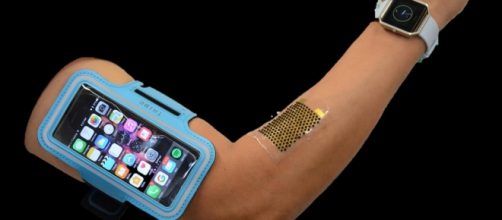A team of engineers from the University of California-San Diego has developed new stretchable Biofuel Cells capable of powering electronics, such as LEDs and Bluetooth radios, using energy extracted from human sweat. Compared to any existing epidermal biofuel cells, UC San Diego’s wearable biofuel cells can generate ten times power. This makes it capable of powering a range of Wearable Devices.
Clever chemistry combined with advanced materials and electronic interfaces
In order to turn sweat into the water, engineers incorporate a certain enzyme in the biofuel cells.
This enzyme can generate current by oxidizing the lactic acid present in human sweat. To make the new biofuel cells flexible and stretchable, the team used the so-called “bridge and island” structure.
The researchers used lithography to manufacture the basis for the bridge and island structure, in which the cell is composed of rows of dots that are connected to each other by spring-shaped structures. The dots are divided into anode and cathode. The spring-shaped structure allows the cell to stretch and bend without deforming the anode and cathode.
Biofuel materials were deposited on top of the dots using screen printing. The engineers also screen printed a 3D carbon nanotube structure on top of the anodes and cathodes.
The 3D carbon nanotube-based cathode and anode arrays allowed more enzymes to each anodic dot and more silver oxide at the cathode dots. The increase in biofuel materials leads to higher energy density, which means that the biofuel cell can generate more energy per surface area. The additional structure also improves the performance of the biofuel cell by making electron transfer easier.
Sweat as a source of constant power
To test out the new biofuel cells, the engineers connected it to a custom-made circuit board. Usually, the power generated by the fuel cells fluctuates depending on the amount of sweat produced by the user. The board is a DC/DC converter that evens out the unstable power, turning it into constant power with a constant voltage.
The team equipped four test subjects with their epidermal biofuel cells and asked them to exercise on a stationary bike. The sweat produced by the subjects during their exercise was able to power a blue LED for about four minutes.
With the positive results of their experiments, the engineers observed two areas of improvement. First, they need to find a more stable substitute for the silver oxide at the cathode. Silver oxide is known to be light sensitive and can degrade over time. Secondly, the engineers need to come up with a way to store energy produced during the peak concentration of lactate in the skin and release it gradually.


